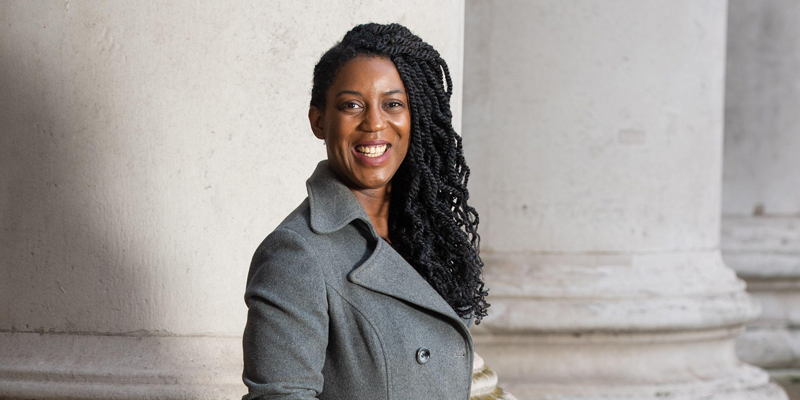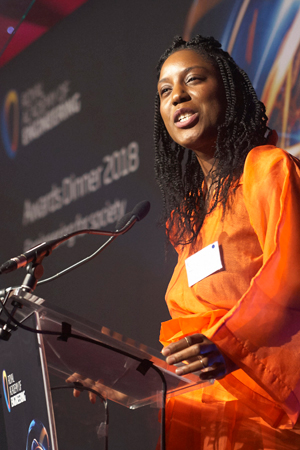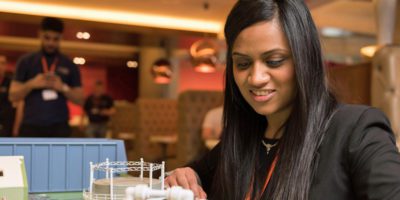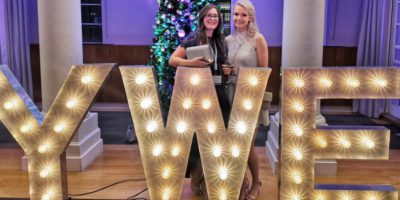Professor Yewande Akinola MBE is an ambassador for clean growth & infrastructure at Innovate UK. An award-winning design engineer and innovator, Yewande has worked for Laing O’Rourke, Arup and Thames Water and also presented Channel 4 and National Geographic’s ‘Titanic: the Mission (Rebuilding Titanic)’. Yewande is a Royal Academy of Engineering Visiting Professor at the University of Westminster, a steering committee member for the Royal Academy of Engineering’s Africa CATALYST and a board trustee at the Institution of Engineering and Technology.
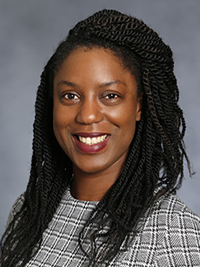
“The idea of sustainability is about solving a global issue and serving diverse communities. Companies need to have diverse teams serving the diversity in the communities that they serve. It’s so important because if we’re going to get the complete story (towards a complete solution), we need representation of the complete problem/challenge.”
Engineer, innovator, dreamer
I am an engineer and an innovator. And I guess the dreamer bit is me, literally having my head in the clouds most times because that’s usually where I start from when I’m trying to solve problems. I have worked as a design consultant, as well as a construction innovator. I’ve worked as an engineer since I graduated in 2007.
From a very young age I was very interested in buildings and how they came together. I was also interested in imagining what my dream home would look like, so I spent so many hours as a young child, just messing about with bits of paper, building models and imagining new spaces. I often thought: “One day when I have lots of money, I’d be able to build a house like this.”
Not long before I started to apply to universities, my mum asked me to consider engineering. She presented the idea that I would be able to work on different aspects of problem-solving in water, transport, power supply. To be honest, I applied to universities to study engineering mostly because I was just trying to keep her happy. But then I found an engineering programme that had a massive bias towards developing countries. So, I applied to that, got a place there, and accepted the offer.
I started off in water, I worked for a year with Thames Water in between my second my third year, and then joined the Environmental Services team at Arup, where I learned how to innovate and how to apply creative ideas to problems. That soon included the technical management of the design of mechanicals and electrical systems within buildings in schools, hospitals, airports, super high-rise buildings – the works! I’m super grateful for the journey. I certainly haven’t looked back at all.
Becoming an ambassador for Innovate UK
A few months ago, I was approached by a recruiter who described Innovate UK’s brilliant ambition to appoint ambassadors – to progress its strategic goals and enable opportunities for UK businesses, amongst others.
A lot of people know Innovate UK the organisation as extremely active in growing the UK economy – by stimulating and supporting innovation through grants. The ambition aligned with my passion, because having spent time in the design consultancy and construction industries – pushing for sustainable infrastructure, new ways of thinking of things, I could see its promise.
There’s a lot of incredible stuff happening in green energy – around food production, towards sustainable infrastructure, and rethinking how we bring buildings together, and how we align it to the way we also consume energy in this country. My role sits at the heart of that, to be able to see what is happening, to be able to encourage even better work to happen. It’s also about connecting the dots where they need connecting, and feeding back into Innovate UK what the trends are coming from industry so the organisation can better respond
It’s hugely exciting because if I was to create a time capsule of right now, I can imagine people looking back at 2020, 2021, 2022 and thinking: “Wow, the evolution/revolution was happening then and maybe people didn’t quite realise it. But all the efforts, all the research, all the prototypes that were been built at that time have changed the way we exist, the way we live, the way we consume.” Hopefully, in 50 years when we look back, we’ll be able to see how we transformed our planet and made it more sustainable.
Innovate UK is the government’s (non-departmental) innovation agency. To date, it has invested more than £2.5 billion in innovation in this country. The ambition is to drive the economy. What we have to offer is new thinking, new ways of doing things, and efficient ways of doing things – those are our main exports. I’ve worked in other parts of the world and I love that in some design areas, people know to call the Brits when they want to come up with ideas for spectacular or difficult projects. Our offering needs to grow.
Innovate UK – Women in Innovation
Innovate UK launched Women in Innovation because they had been receiving very few applications from female innovators. To tackle the issue the question posed was whether they were there or whether we just weren’t reaching them?
After analysing the findings and coming up a with a plan the programme was launched to support women in innovation. The scheme has been designed to offer mentoring and training as well as an opportunity to receive £50000. We need programmes like this and Innovate UK is being intentional about solving a problem.
Obtaining a patent for a rainwater harvesting system
To me there is huge importance in having a great mentor in your job. When I, when I joined Arup, I was assigned to a wonderful engineer called David George. Literally from the first day I turned up he would sketch out ideas and just drop them on my table. I’d rock up in the morning and there would be all these colourful sketches on my desk to help me start my day.
That is how I learnt engineering, how to express my ideas. He would challenge me on all fronts. So, when we were given a project to design a rainwater harvesting system, initially for an office building, he said: “Typical rainwater harvesting ideas collect water from the roof, it goes down a pipe, you find a tank in the ground somewhere, there’s a massive pump working away to redistribute the water back into the building. That is the typical response. But I want us to come up with something different. There’s gravity – why don’t we just use gravity?”
The idea evolved and eventually became a solution for a school where we collected the water directly from the roof, sent it down a pipe into large tanks that replaced the cisterns in the toilets. We were collecting and filtering through the downpipes and there was a viewing turret so the kids could see the water coming down from the roof.
This influenced my approach to design and taught me to ask “How can I make this different? How can I make it more efficient?” David was very kind to include me in the application for a patent for the idea.
Move over, Kate Winslet
I was at work one day when an email popped into my inbox from one of my colleagues. The email was forwarded from a production company. They were looking for engineers to present a programme that would tell the stories of the men and women who built the Titanic. At this point my head was very much in the Kate Winslet/Leonardo DiCaprio space and I decided I’d be up for it as a little bit of fun. So, I responded and all of a sudden it became quite serious.
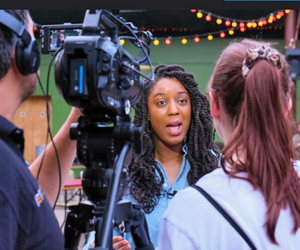
I ended up becoming part of this incredible team – from a production company called Twenty Twenty and working alongside presenters Brendan Walker, Luke Perry and Dave Wilkes. It required me to take over four months off work because we were filming the rebuilding of parts of the Titanic – built to the original specification.
Recreating parts of the Titanic
We took on different challenges. We built a section of the bow up in Belfast and also a section of a smoking room with all the stained glass. I went through the process of learning how to make glass. We built the chairs that they would have had on the Titanic, and the rooms that you’d have seen in third class, for example.
It was so humbling because it revealed the challenges that the men and the women who built it were up against. There were shipbuilders who would work seven days a week. And to think that it is now sitting at the bottom of the sea. People told us the stories of their grandparents who worked as shipbuilders.
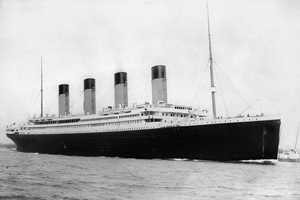
You also think of the women who worked hard to process the cotton and make the very luxurious drapes of curtains and the furniture. There was zero possibility of them one day sailing on the Titanic and going to America as they would never have been able to afford the ticket.
The section of the bow we had built, I think is still up in Belfast, not too far from the Titanic museum. We left it as a monument. We also had a 16-tonne replica anchor made by Forgemasters in Sheffield. It was incredible to see it being cast- the metal poured and the anchor head being taken out of the mould.
There was also a wonderful procession through Dudley on a Saturday morning too where about 10,000 people came along to follow part of the route that the anchor had taken as it has been delivered, pulled by 20 shire horses. It was just amazing.
Diverse teams serving diverse communities
I’ve worked on projects in this country, I’ve worked in projects in the Middle East, I’ve worked on projects in the Far East, and lived in different countries. The perspective the international view on things has given me is the reason I am convinced that when you have diversity (and therefore a richness of different approaches and different perspectives in a team) there is so much more value in what the team is able to offer.
It breaks my heart when I see doors being closed to diversity. When I relate that to solving world problems I’m thinking: “Gosh, as a business you are losing out on so much because you’re missing out on the richness of different people and their different perspectives.” The idea of sustainability is about solving a global issue and serving diverse communities.
Companies need to have diverse teams serving the diversity in the communities that they serve. It’s so important because if we’re going to get the complete story (towards a complete solution), we need representation of the complete problem/challenge.
Going on the journey of learning
I’m really excited about my work with Innovate UK. It has also been an exciting steep learning curve – expanding out from sustainable infrastructure to aspects of clean growth such as food production innovation, battery technologies and more. I’m excited to go on the journey of learning.
I completed a very intensive programme at MIT last year, and that fired something inside of me and made me really thirsty for new knowledge, connecting the dots and exploring what is possible, so I’m keen to apply that.
A plea to employers: Young people need your help more than ever. Let us help you to help them
Last year, I ran a virtual work experience week for students from about 22 different countries. They discovered what it’s like working as part of a team and got an insight into Industry. And I’m excited to run that again this year.
The chances are there will still be a shortage of work experience opportunities this year because of the pandemic. I just want to make sure that 100, 200, 300, 400 more students at least have a bit of a glimpse into the industry and are inspired to carry on with engineering and technology, even after their university studies.
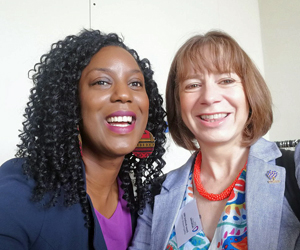
The other thing I’m just so interested in is skills. I sit on the Council of the University of Warwick and I’m a Royal Academy of Engineering Visiting Professor at Westminster. We need to serve our young people as best as we can by exposing them to as much as possible through organisations opening their doors to them. It costs them nothing.
If somebody said: “You’ve got two minutes, here’s the microphone, what would you say to organisations?” I’d say: “Please, just open your doors to as many diverse young people as possible. If you want to run a work experience week in 2021 and you’re not sure what to do please come to me so I can help you do a lot of the heavy lifting. You just need to make members of your teams available to the students and I can create the platform for you to get that engagement.”
https://www.linkedin.com/in/yewande-akinola-mbe-fiet-honfreng-78888518/

